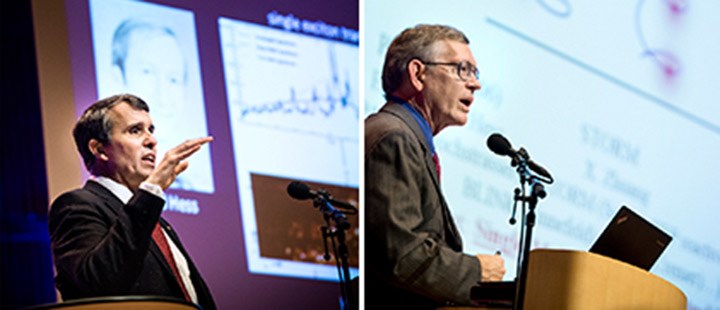Nobel laureates meeting with researchers and students
Sofie Björklund and David Wigren are both chemistry students at Örebro University. When two of this year’s Nobel Prize winners in chemistry visited the university, Sofie and David were given the opportunity to put some questions to the laureates.

One of the questions dealt with young people’s attitude to research. Why should young students consider a career in research?
“It is good fun and amazing to be able to discover and develop,” said William E. Moerner. “What could be more exciting than to be able to see the light emitted from one single molecule?”
“It is an incredibly interesting line of work and great fun to be able to explore the things that interest you the most,” said Eric Betzig.
The home of Alfred Nobel
Initially, there were plans for all three Nobel laureates in chemistry to come to Örebro, but unfortunately Stefan W. Hell had to cancel at the last minute. It was therefore William E. Moerner and Eric Betzig who got to experience the day-and-a-half-long programme.
The visit began on the Sunday with a guided tour of Alfred Nobel’s home Björkborn Manor in Karlskoga, followed by a dinner at Örebro castle. On the Monday, they visited the chemistry department at Örebro University, which included sessions with researchers and students. They also gave a guest lecture which was open to the public.
It is not every day a young university has the chance to showcase itself to Nobel Prize winners and professor of chemistry Bert van Bavel was thrilled at the opportunity to introduce the research undertaken at the department.
Environmental pollutants
“We are proud and successful both in terms of our research and the training we offer. Our study programme in chemistry specialising in forensics is one of the most popular programmes in the country and our research on different environmental pollutants is renowned internationally. We are working with a different technique than that for which the Nobel laureates were awarded, but I hope that we will be able to find areas of common ground where different techniques may complement each other,” he says.
A major cornerstone of the work undertaken at the research environment Man-Technology-Environment, MTM, is the development of analytical methods to assess the occurrence of persistent organic pollutants, POPs. These are regulated by the Stockholm Convention, a global treaty to reduce the emission and discharge of such pollutants.
The laboratory at Örebro University has for some time also been a reference laboratory within the United Nations Environment Programme (UNEP) and during the Nobel laureates’ visit, scientists at the laboratory were able to demonstrate how to analyse suspected pollutants using mass spectrometry. Through its collaboration with Waters Corporation, a world-leading manufacturer of sophisticated analytical instruments, Örebro University is able to use the very latest technology within mass spectrometry.
